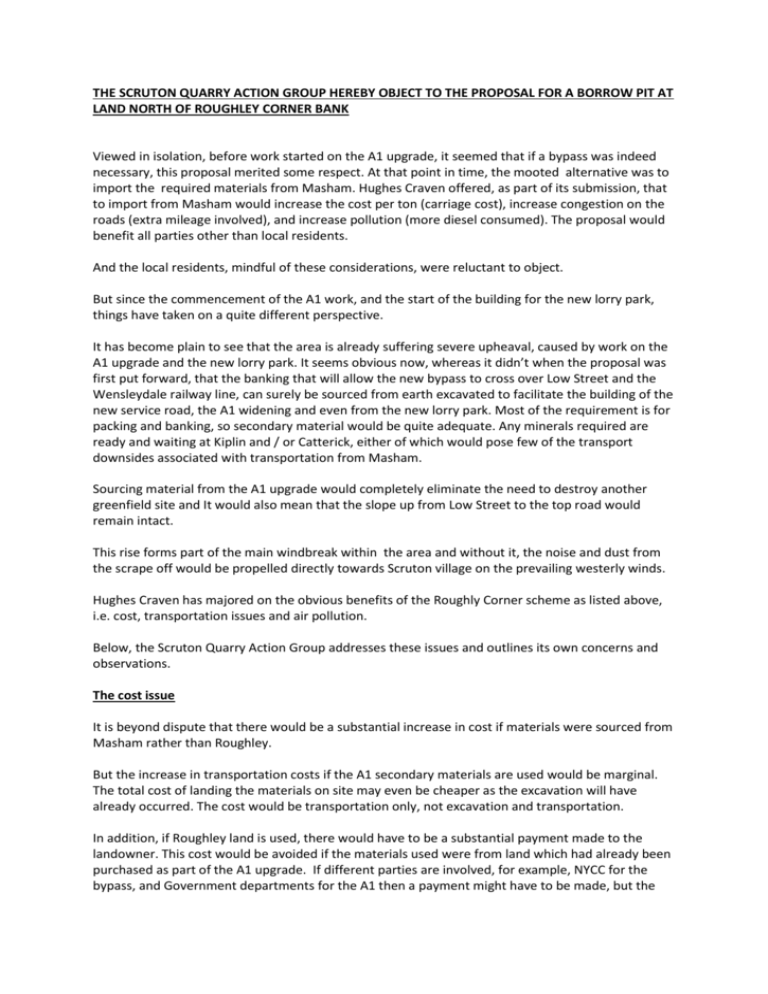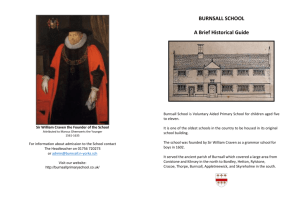the scruton quarry action group hereby object to the proposal for a
advertisement

THE SCRUTON QUARRY ACTION GROUP HEREBY OBJECT TO THE PROPOSAL FOR A BORROW PIT AT LAND NORTH OF ROUGHLEY CORNER BANK Viewed in isolation, before work started on the A1 upgrade, it seemed that if a bypass was indeed necessary, this proposal merited some respect. At that point in time, the mooted alternative was to import the required materials from Masham. Hughes Craven offered, as part of its submission, that to import from Masham would increase the cost per ton (carriage cost), increase congestion on the roads (extra mileage involved), and increase pollution (more diesel consumed). The proposal would benefit all parties other than local residents. And the local residents, mindful of these considerations, were reluctant to object. But since the commencement of the A1 work, and the start of the building for the new lorry park, things have taken on a quite different perspective. It has become plain to see that the area is already suffering severe upheaval, caused by work on the A1 upgrade and the new lorry park. It seems obvious now, whereas it didn’t when the proposal was first put forward, that the banking that will allow the new bypass to cross over Low Street and the Wensleydale railway line, can surely be sourced from earth excavated to facilitate the building of the new service road, the A1 widening and even from the new lorry park. Most of the requirement is for packing and banking, so secondary material would be quite adequate. Any minerals required are ready and waiting at Kiplin and / or Catterick, either of which would pose few of the transport downsides associated with transportation from Masham. Sourcing material from the A1 upgrade would completely eliminate the need to destroy another greenfield site and It would also mean that the slope up from Low Street to the top road would remain intact. This rise forms part of the main windbreak within the area and without it, the noise and dust from the scrape off would be propelled directly towards Scruton village on the prevailing westerly winds. Hughes Craven has majored on the obvious benefits of the Roughly Corner scheme as listed above, i.e. cost, transportation issues and air pollution. Below, the Scruton Quarry Action Group addresses these issues and outlines its own concerns and observations. The cost issue It is beyond dispute that there would be a substantial increase in cost if materials were sourced from Masham rather than Roughley. But the increase in transportation costs if the A1 secondary materials are used would be marginal. The total cost of landing the materials on site may even be cheaper as the excavation will have already occurred. The cost would be transportation only, not excavation and transportation. In addition, if Roughley land is used, there would have to be a substantial payment made to the landowner. This cost would be avoided if the materials used were from land which had already been purchased as part of the A1 upgrade. If different parties are involved, for example, NYCC for the bypass, and Government departments for the A1 then a payment might have to be made, but the cost to one scheme would be to the direct benefit of the other. The taxpayer would benefit rather than an individual. Should the A1 scrape not be of sufficient quality, Minerals and Waste dept have stated that the existing quarry at Kiplin has sufficient materials to meet the needs. Whilst this is a greater distance the minerals are already being quarried (no addl restoration costs) Transportation is along main roads (passing through Catterick) and straight on to the A1. There would be no use of fuel to power the plant for excavation at Roughley so offsetting the extra transportation costs. Furthermore, there would be heavy restoration costs involved in making good the Roughley area after completion of work. These would be eliminated if A1 materials were used, as restoration for this project has already been budgeted for. Surely, cold logic suggests that in terms of the bypass project, the A1 option comes out significantly cheaper than the alternative Roughley proposal. Traffic issues and congestion. Hughes Craven set great store on the fact that the Roughley proposal involves only 290 metres of transportation on local roads. This is certainly much less than would be the case if the transportation was from Masham. But Hughes Craven estimate between 100 and 150 vehicles per day will use this stretch of Low Street which is an awful lot of movement along such a small road. Using A 1 materials would allow for wagons to cross the road at Leeming junction, come across the two new roundabouts and enter the site without touching Low Street or passing any houses. Materials to be used to the west of Low Street would not use the road at all. A simple crossing of Low Street, something in the manner of a train crossing, would carry the materials needed for the Eastern portion of the site. The total distance on Low Street would be reduced from 290 metres to about 6 metres, ie the width of the road. This is a matter of greater importance than once it would have been, due to two factors. Firstly, traffic on Low Street is at a higher level now than at any time in the past because all Northbound traffic from Kirkby Fleetham now must travel south along Low Street to get on to the A1. The right turn at the northern end of Low Street is no longer in use. The only alternative for Fleetham villagers would be to go through Scruton which would bring its own set of problems. Secondly, during the first phase of the A1 upgrade, Low Street was used extensively by vehicles supplying materials for the A1. If the same thing happens on the second phase there will be a significant increase in traffic levels even before any road useage by wagons supplying bypass materials. Low Street was a dangerous place during phase one. It would be even more dangerous against this background. If the potential for an accident on the North bound A1 is factored in, which necessitated Low Street being used for detour traffic, the whole area would become completely logjammed. And all this is on a road which is part of the National Cycle network and forms the only reasonable exercise road for the horses stabled at the top of Roughley bank as well as being used extensively by pedestrians walking children and dogs. Required minerals sourced from Kiplin or Catterick would use wide roads which are much more suitable and would not need to pass through quiet villages. Hughes Craven reason, that once people become aware of this issue, they will avoid the area. The truth of the matter is that many people won’t be able to, and those that can will cause congestion elsewhere, particularly in Scruton village. Tourists visiting the cycle network would probably be unaware of it and use it anyway. If they became aware of it and declined to return, local businesses such as shops and hotels would suffer loss of trade. Restoration issues. It is our view that the planned restoration outcome will result in loss of amenity to local residents and will result in permanent loss of tranquillity. This is a tourist area and the plans indicate that the end result will be totally incongruous to this background. Also, there is indication that there could be water spill from the field on to Low Street which is already prone to flooding. Practicalities. Hughes Craven has stated that secondary material COULD prove unsuitable. The view of the action group concurs with the one already expressed by’ Minerals and Waste’ that secondary material almost certainly would be suitable, and is also more sustainable. Health and Welfare. The action group is concerned about the impact of dust and noise. Dust. In its submission, Hughes Craven goes into some detail regarding dust size and weight. The conclusion is that there are nine potential receptors of dust but the probability is that only three are at risk and only one seriously so. It is hard for groups such as ours to contradict these findings, but nevertheless, there remain grave misgivings. What we do know is that he winds in this particular region are extraordinarily fierce and can swing violently. The suspicion is that dust will travel much further than anticipated because of this, perhaps even as far as Scruton village. The group opines, the assumption that only the houses the west of the site are in at risk, is ersatz. Experience has proved that the winds can be just as fierce when blowing from the south or the north. It is a matter of some certainty that many more properties than the nine which have been identified will be affected or at risk. Noise The action group believes that there has been no submission of e[-xisting nose levels offered up by Hughes Craven and so there must be question marks as too whether or not the noise levels can be kept within acceptable limits. Indeed, Environmental Health has assessed the existing level at 50 decibels. This is only 5 decibels below the acceptable limit of 55. Depending upon when that assessment was carried out, the noise level may even now be higher than the quoted figure due to the workings at the lorry park. It is understood that if the project goes ahead, then it will be operational five and a half days a week for 12 hours a day. Estimates show that for two months in every twelve months noise levels would increase to and remain at an unacceptable level of 70 decibels. Conclusion. The action group has closely examined all aspects of this proposal and is of the firm opinion that the reasoning behind it is flawed. Initially it looked like a sensible option, but subsequent developments and closer examination of facts and alternatives indicate this is very far from the case. Using A1 scrape off would be quicker, cheaper, and cause less damage to the area and less nuisance to local residents. For this reason the group now issues this objection.


